Picasso's Rose Period
Picasso's Rose Period represents an important epoch in the life and work of the Spanish artist Pablo Picasso and had a great impact on the developments of modern art. It began in 1904 at a time when Picasso settled in Montmartre at the Bateau-Lavoir among bohemian poets and writers. Following Picasso's Blue Period, depicting themes of poverty, loneliness, and despair in somber tones of daunting blues, Picasso's Rose Period represents more pleasant themes of clowns, harlequins, and carnival performers, depicted in cheerful vivid hues of red, orange, pink and earth tones.
%252C_oil_on_canvas%252C_191.1_x_108.6_cm%252C_The_Barnes_Foundation%252C_Philadelphia.jpg.webp)
Based largely on intuition rather than direct observation, Picasso's Rose Period marks the beginning of the artists' stylistic experiments with primitivism; influenced by pre-Roman Iberian sculpture, Oceanic and African art. This led to Picasso's African Period in 1907, culminating in the Proto-Cubist Les Demoiselles d'Avignon, regarded as a masterpiece.[1][2][3]
Overview
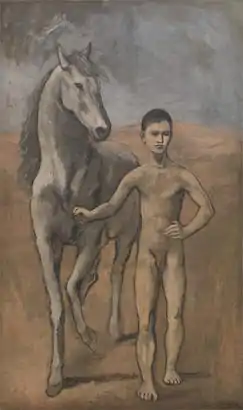
The Rose Period lasted from 1904 to 1906.[2] Picasso was happy in his relationship with Fernande Olivier whom he had met in 1904 and this has been suggested as one of the possible reasons he changed his style of painting. Harlequins, circus performers and clowns appear frequently in the Rose Period and populated Picasso's paintings at various stages throughout the rest of his long career. The harlequin, a comedic character usually depicted in checkered patterned clothing, became a personal symbol for Picasso.
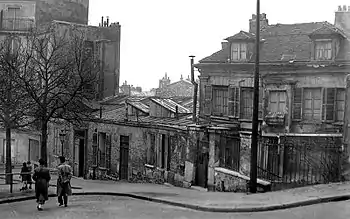
The Rose Period has been considered French influenced, while the Blue Period more Spanish influenced, although both styles emerged while Picasso was living in Paris. Picasso's Blue Period began in late 1901, following the death of his friend Carlos Casagemas and the onset of a bout of major depression.[4] It lasted until 1904, when Picasso's psychological condition improved. The Rose Period is named after Picasso's heavy use of pink tones in his works from this period, from the French word for pink, which is rose.
Picasso's third highest selling painting, Young Girl with a Flower Basket, and his fifth highest, Garçon à la pipe (Boy with a pipe) were both painted during the Rose Period. Other significant Rose Period works include: Woman in a Chemise (Madeleine) (1904–05), The Actor (1904–1905),[5] Lady with a Fan (1905), Two Youths (1905), Harlequin Family (1905), Harlequin's Family With an Ape (1905), La famille de saltimbanques (1905), Boy with a Dog (1905), Nude Boy (1906), Boy Leading a Horse (1905-06), and The Girl with a Goat (1906).
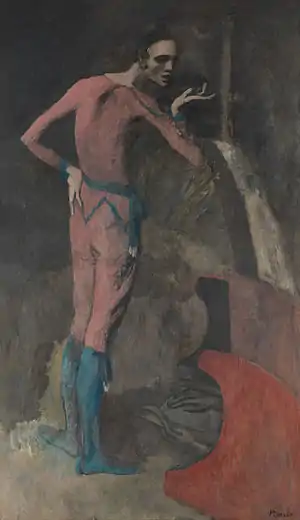 Pablo Picasso, 1904, L'acteur (The Actor), Metropolitan Museum of Art, New York
Pablo Picasso, 1904, L'acteur (The Actor), Metropolitan Museum of Art, New York%252C_oil_on_canvas%252C_147_x_95_cm%252C_The_Pushkin_Museum%252C_Moscow.jpg.webp) Pablo Picasso, 1905, Acrobate à la Boule (Acrobat on a Ball), oil on canvas, 147 × 95 cm, Pushkin Museum, Moscow
Pablo Picasso, 1905, Acrobate à la Boule (Acrobat on a Ball), oil on canvas, 147 × 95 cm, Pushkin Museum, Moscow%252C_gouache_on_canvas%252C_90_x_71_cm_Staatsgalerie%252C_Stuttgart.jpg.webp) Pablo Picasso, 1904–05, Les Baladins (Mother and Child, Acrobats), gouache on canvas, 90 × 71 cm, Staatsgalerie Stuttgart
Pablo Picasso, 1904–05, Les Baladins (Mother and Child, Acrobats), gouache on canvas, 90 × 71 cm, Staatsgalerie Stuttgart.jpg.webp) Pablo Picasso, 1905, Maternité (Mother and Child), private collection
Pablo Picasso, 1905, Maternité (Mother and Child), private collection%252C_pencil_on_paper.jpg.webp) Pablo Picasso, 1905, Nus (Nudes), pencil on paper
Pablo Picasso, 1905, Nus (Nudes), pencil on paper%252C_collage%252C_gouache%252C_watercolor%252C_pastel_and_india_ink_on_carboard%252C_104_x_75_cm%252C_G%C3%B6teborgs_Konstmuseum%252C_Goteburg.jpg.webp) Pablo Picasso, 1905, Acrobat's Family with a Monkey (Famille au Singe), collage, gouache, watercolor, pastel and India ink on cardboard, 104 × 75 cm, Göteborgs Konstmuseum, Gothenburg
Pablo Picasso, 1905, Acrobat's Family with a Monkey (Famille au Singe), collage, gouache, watercolor, pastel and India ink on cardboard, 104 × 75 cm, Göteborgs Konstmuseum, Gothenburg%252C_oil_on_canvas%252C_155_x_66_cm%252C_private_collection%252C_New_York.jpg.webp) Pablo Picasso, 1905, Young Girl with a Flower Basket, oil on canvas, 154.8 x 66.1 cm, private collection
Pablo Picasso, 1905, Young Girl with a Flower Basket, oil on canvas, 154.8 x 66.1 cm, private collection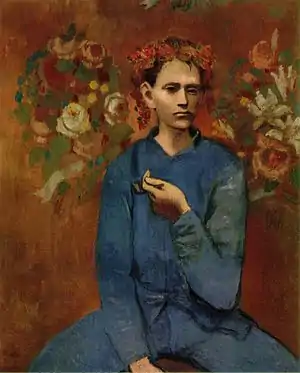 Pablo Picasso, 1905, Garçon à la pipe, (Boy with a Pipe), private collection
Pablo Picasso, 1905, Garçon à la pipe, (Boy with a Pipe), private collection%252C_oil_on_canvas%252C_100.3_x_81_cm%252C_The_National_Gallery_of_Art%252C_Washington%252C_DC.jpg.webp) Pablo Picasso, 1905, Lady with a Fan (Femme à l'éventail), oil on canvas, 100.3 × 81 cm, National Gallery of Art, Washington, D.C.
Pablo Picasso, 1905, Lady with a Fan (Femme à l'éventail), oil on canvas, 100.3 × 81 cm, National Gallery of Art, Washington, D.C. Pablo Picasso, 1905, Family of Saltimbanques, National Gallery of Art, Washington, D.C.
Pablo Picasso, 1905, Family of Saltimbanques, National Gallery of Art, Washington, D.C.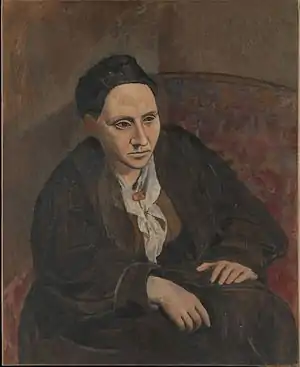 Pablo Picasso, 1905-06, Portrait of Gertrude Stein, oil on canvas, 100 x 81.3 cm Metropolitan Museum of Art, New York City
Pablo Picasso, 1905-06, Portrait of Gertrude Stein, oil on canvas, 100 x 81.3 cm Metropolitan Museum of Art, New York City%252C_oil_on_canvas%252C_141.4_x_97.1_cm%252C_Kunstmuseum_Basel.jpg.webp) Pablo Picasso, 1905–06, Les deux frères (The two brothers), oil on canvas, 141.4 × 97.1 cm, Kunstmuseum Basel
Pablo Picasso, 1905–06, Les deux frères (The two brothers), oil on canvas, 141.4 × 97.1 cm, Kunstmuseum Basel%252C_gouache_and_pencil_on_board%252C_68.5_x_96_cm%252C_private_collection.jpg.webp) Pablo Picasso, 1906, La Mort d'Arlequin (Death of Harlequin), gouache and pencil on board, 68.5 × 96 cm, private collection
Pablo Picasso, 1906, La Mort d'Arlequin (Death of Harlequin), gouache and pencil on board, 68.5 × 96 cm, private collection Pablo Picasso, 1906, Nu aux mains serrées, gouache on canvas, 96.5 × 75.6 cm, Art Gallery of Ontario
Pablo Picasso, 1906, Nu aux mains serrées, gouache on canvas, 96.5 × 75.6 cm, Art Gallery of Ontario
See also
References
- Voorhies, James. Pablo Picasso (1881–1973), Heilbrunn Timeline of Art History, The Metropolitan Museum of Art, New York, 2000
- Wattenmaker, Richard J.; Distel, Anne, et al.,1993, p. 194
- Richardson John. A Life Of Picasso. The Prodigy, 1881–1906, Dionysos p. 475. New York: Alfred A. Knopf, 1991. ISBN 978-0-307-26666-8
- Solomon, Barbara Probst (September 11, 1995). "Callow Young Genius". New York Magazine. p. 83.
- Staff, "New York woman falls, rips Picasso painting," AP, January 25, 2010, found at Yahoo News files. Accessed January 25, 2010.
Suggested reading
- Wattenmaker, Richard J.; Distel, Anne, et al. (1993). Great French Paintings from the Barnes Foundation. New York: Alfred A. Knopf. ISBN 0-679-40963-7